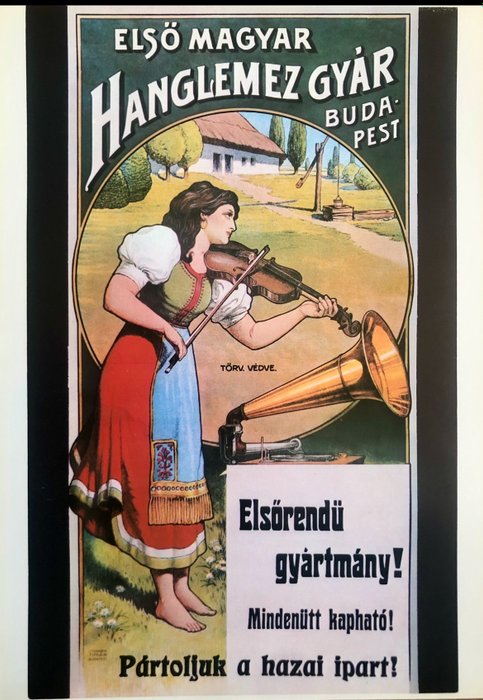
Endre Sarossy - Szerencsi Chocolate - Beer - Budapest - Hungary - poster - 1970s
No. 83234551

No. 83234551

Official 1979 print of original one - see last photo
“
Protected by patent.
First-class
manufacture!
Available everywhere!
Support domestic industry”
—
Földes Imre
1881 - 1948
Imre Foldes
Important master of the early Hungarian poster art, together with Lipót Sátori, they layed the foundation of the Hungarian film poster design. Földes was a prolific artist, he designed a lot of political and commercial posters as well.
He was born Imre Feld, his family was Jewish. Földes started his career as a lithographer. He was studying at the Iparrajziskola and in the Mintarajztanoda (major art schools in Pest at the time), later he visited München, Berlin and Paris.
Besides beeing a leading figure in poster art, he was a painter and a graphic artist as well. He exhibited his artworks frequently in Budapest, he participated in the Nemzeti Szalon (National Salon) for instance.
Starting from the 1910s, his posters overwhelmed the streets of Budapest. Between 1918 and 1919, he opened a design studio with Lipót Sátori, and they collaborated on many poster designs.
During the First World War, he created film, commercial and propaganda posters, and he made one work for the Hungarian Soviet Republic as well. After the war, he designed political posters for several parties (most of them depicting Hungary's borders before the Treaty of Trianon).
From the 1920s on, he lived in Transylvania, and his posters rarely appeared on the streets in Hungary. He was working for a magazine (‘Helikon’) in Temesvár. The circumstances of his death are not clear until this day.
Földes has channelled his drawing talent into his fine posters. Most of them represent perfectly shaped, often caricature-like figures. His posters are fine pieces from the Hungarian Art Noveau or secessionist period. Some of his works – especially his fashion posters – represent decorative and graceful female figures. He gave an important role for typography in most of his compositions. His secessionist style became more and more complete, more colourful and painting-like. He invented effective visual symbols for companies and political parties. Good examples are his designs for the magazine “Pesti Napló” or his posters for he “Gazdasági” (Economy) or “Polgári” (Civic) Parties.
—
About Hungarian Poster Art
Hungarian poster art has long been celebrated for its unique and captivating style, making it a significant cultural and artistic movement in the world. From the late 19th century to the present day, Hungarian poster art has left an indelible mark on the global art scene, with its innovative techniques, bold designs, and powerful messages.
One of the highlights of Hungarian poster art is its ability to seamlessly blend various artistic styles and influences. The movement drew inspiration from a wide range of sources, including Art Nouveau, Constructivism, and Surrealism, resulting in a diverse and eclectic body of work. Artists such as Mihály Bíró, József Bottlik, and István Irsai pushed the boundaries of traditional poster design, experimenting with typography, color, and composition to create visually striking and thought-provoking pieces.
Another notable aspect of Hungarian poster art is its emphasis on storytelling and narrative. Unlike many other countries' posters, which primarily served as advertising tools, Hungarian posters often conveyed a deeper meaning or social commentary. They were not just meant to sell products but also to engage viewers intellectually and emotionally. This storytelling approach allowed Hungarian poster art to transcend its commercial purpose and become a powerful medium for social and political expression.
The importance of Hungarian poster art in the world cannot be overstated. During the early 20th century, Hungary was at the forefront of graphic design, and its posters gained international recognition and acclaim. The Budapest School, a group of Hungarian artists, revolutionized the field with their avant-garde approach, influencing poster art movements across Europe and beyond. Their innovative techniques and artistic vision set new standards for poster design, inspiring generations of artists worldwide.
Furthermore, Hungarian poster art played a crucial role in shaping public opinion and mobilizing society. In times of political turmoil and social change, posters became a powerful tool for propaganda and activism. During World War II and the Hungarian Revolution of 1956, posters were used to rally support, convey messages of resistance, and document historical events. The ability of Hungarian artists to capture the spirit of the times and communicate complex ideas through visual imagery made their posters an integral part of the nation's cultural and political identity.
Today, Hungarian poster art continues to thrive, with contemporary artists carrying on the legacy of their predecessors. The Hungarian Poster Museum in Budapest showcases the rich history and evolution of this art form, attracting visitors from around the world. The enduring appeal and influence of Hungarian poster art can be seen in the works of renowned artists like Tibor Helényi and István Orosz, who have successfully merged traditional techniques with modern aesthetics.
In conclusion, Hungarian poster art stands as a testament to the country's artistic prowess and cultural heritage. Its unique style, emphasis on storytelling, and ability to provoke thought and emotion have made it an important and influential movement in the world. From its early beginnings to the present day, Hungarian poster art continues to captivate audiences and inspire artists, leaving an indelible mark on the global art scene.
—
Please note that our company was founded in 1994 and it is internationally trackable. Invoice is available upon request.
Our team consists of members with university degree of art, painting valuation experts and experienced art&antique dealers
Feel free to ask as much as you want. Lifetime warranty is available for all items originality.
Shipping is with insurance.
How to buy on Catawiki
1. Discover something special
2. Place the top bid
3. Make a secure payment